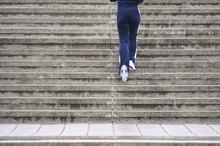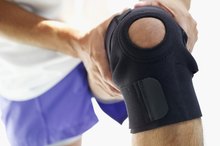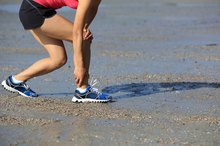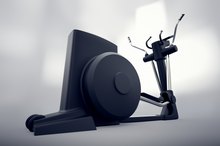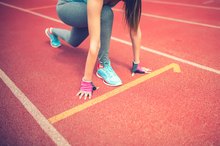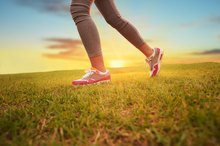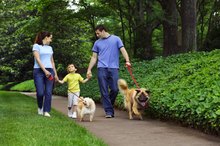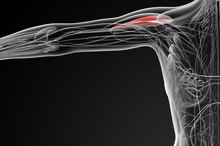What does fact checked mean?
At Healthfully, we strive to deliver objective content that is accurate and up-to-date. Our team periodically reviews articles in order to ensure content quality. The sources cited below consist of evidence from peer-reviewed journals, prominent medical organizations, academic associations, and government data.
The information contained on this site is for informational purposes only, and should not be used as a substitute for the advice of a professional health care provider. Please check with the appropriate physician regarding health questions and concerns. Although we strive to deliver accurate and up-to-date information, no guarantee to that effect is made.
Buttocks & Leg Pain
Buttock and leg pain may occur as the result of strenuous activity, injury or nerve pain. Pain in the legs and buttocks most often results from muscle pain after beginning a new exercise or from overuse of the muscles. The first step toward relieving buttocks and leg pain is identifying its cause.
If you are experiencing serious medical symptoms, seek emergency treatment immediately.
Muscle Aches
If you recently started a new exercise regimen that puts a lot of strain on your legs or requires your leg muscles to work harder than normal, you will likely experience buttocks and leg pain the day after your activity. Exercises such as jogging or leg lifts often result in muscle pain and fatigue the following day. This pain will likely decrease as your muscles become accustomed to the additional work. Resting for a day in between workouts will help prevent injury and allow your muscles time to recover from a tough workout.
- If you recently started a new exercise regimen that puts a lot of strain on your legs or requires your leg muscles to work harder than normal, you will likely experience buttocks and leg pain the day after your activity.
- Exercises such as jogging or leg lifts often result in muscle pain and fatigue the following day.
Injuries
Sore Muscles & Stair Climbing
Learn More
You may experience pain in your leg or buttocks area if you have injured yourself. Unlike the mild pain that occurs when beginning a workout routine, pain from an injury may occur suddenly and be more severe. The hamstrings near your buttocks and upper thigh may become injured when you attempt a strenuous workout without stretching first or when your muscles are weak from inactivity. Symptoms of a tear in the hamstring muscles include swelling, bruising, tenderness, weakness and a tearing sensation in the muscle. You may also be unable to fully bear weight on the affected leg.
- You may experience pain in your leg or buttocks area if you have injured yourself.
- The hamstrings near your buttocks and upper thigh may become injured when you attempt a strenuous workout without stretching first or when your muscles are weak from inactivity.
Nerve Pain
Nerve pain, or peripheral neuropathy, occurs when the nerves cannot properly transmit information to the brain 2. The pain primarily begins in the feet and legs and progresses toward the center of the body as the condition worsens. According to Medline Plus, a common cause of peripheral neuropathy is diabetes 2. Symptoms of peripheral neuropathy include a burning sensation, tingling, pain and other sensation changes in the feet and legs 2. An inability to determine joint position, resulting in a lack of coordination, may also occur.
Treatment
VMO Strengthening Exercises
Learn More
For muscle pain that results from a new exercise routine, a day of rest between workouts may be all you need for pain relief. For an injury, a physician may recommend that you use crutches to keep weight off the leg while it heals. Over-the-counter anti-inflammatory medications may help relieve the pain. After sufficient healing time, you may need to undergo physical therapy. For nerve pain, a physician can prescribe medications that effectively treat peripheral neuropathy and may also recommend physical therapy 2.
- For muscle pain that results from a new exercise routine, a day of rest between workouts may be all you need for pain relief.
- For nerve pain, a physician can prescribe medications that effectively treat peripheral neuropathy and may also recommend physical therapy 2.
Related Articles
References
- University of Wisconsin-Madison Health: This Month in Sports Rehabilitation -- Tips to Prevent Hamstring Injuries
- Medline Plus: Peripheral Neuropathy
- Colloca L, Ludman T, Bouhassira D, et al. Neuropathic pain. Nat Rev Dis Primers. 2017;3:17002. Published 2017 Feb 16. doi:10.1038/nrdp.2017.2
- Lima MA, Maranhão-filho P. What is the essential neurological examination?. Arq Neuropsiquiatr. 2012;70(12):939-41. doi:10.1590/s0004-282x2012001200007
- Marchettini P, Lacerenza M, Mauri E, Marangoni C. Painful peripheral neuropathies. Curr Neuropharmacol. 2006;4(3):175–181. doi:10.2174/157015906778019536
- Sommer C, Geber C, Young P, Forst R, Birklein F, Schoser B. Polyneuropathies. Dtsch Arztebl Int. 2018;115(6):83–90. doi:10.3238/arztebl.2018.083
- Koop LK, Tadi P. Neuroanatomy, Sensory Nerves. [Updated 2019 Apr 7]. In: StatPearls [Internet]. Treasure Island (FL): StatPearls Publishing; 2019 Jan-.
- McCorry LK. Physiology of the autonomic nervous system. Am J Pharm Educ. 2007;71(4):78. doi:10.5688/aj710478
- Tracy JA, Dyck PJ. The spectrum of diabetic neuropathies. Phys Med Rehabil Clin N Am. 2008;19(1):1–v. doi:10.1016/j.pmr.2007.10.010
- Ekabe CJ, Kehbila J, Abanda MH, Kadia BM, Sama CB, Monekosso GL. Vitamin B12 deficiency neuropathy; a rare diagnosis in young adults: a case report. BMC Res Notes. 2017 Jan 28;10(1):72. doi: 10.1186/s13104-017-2393-3
- Dimachkie MM, Barohn RJ. Guillain-Barré syndrome and variants. Neurol Clin. 2013;31(2):491–510. doi:10.1016/j.ncl.2013.01.005
- Menorca RM, Fussell TS, Elfar JC. Nerve physiology: mechanisms of injury and recovery. Hand Clin. 2013;29(3):317–330. doi:10.1016/j.hcl.2013.04.002
- Aroori S, Spence RA. Carpal tunnel syndrome. Ulster Med J. 2008;77(1):6–17. PMID: 18269111
- Cojocaru IM, Cojocaru M, Silosi I, Vrabie CD. Peripheral nervous system manifestations in systemic autoimmune diseases. Maedica (Buchar). 2014 Sep;9(3):289-94.
- Misra UK, Kalita J, Nair PP. Diagnostic approach to peripheral neuropathy. Ann Indian Acad Neurol. 2008;11(2):89–97. doi:10.4103/0972-2327.41875
- Jensen TS, Finnerup NB. Allodynia and hyperalgesia in neuropathic pain: clinical manifestations and mechanisms. Lancet Neurol. 2014;13(9):924-35. doi:10.1016/S1474-4422(14)70102-4
- Aman JE, Elangovan N, Yeh IL, Konczak J. The effectiveness of proprioceptive training for improving motor function: a systematic review. Front Hum Neurosci. 2015;8:1075. Published 2015 Jan 28. doi:10.3389/fnhum.2014.01075
- Desai J, Swash M. Fasciculations: what do we know of their significance?. J Neurol Sci. 1997;152 Suppl 1:S43-8. doi:10.1016/s0022-510x(97)00243-8
- Sommer C, Geber C, Young P, Forst R, Birklein F, Schoser B. Polyneuropathies. Dtsch Arztebl Int. 2018 Feb 9;115(6):83-90. doi: 10.3238/arztebl.2018.083.
- Wells R, Tonkin A. Clinical approach to autonomic dysfunction. Intern Med J. 2016;46(10):1134-1139. doi:10.1111/imj.13216
- Chopra K, Tiwari V. Alcoholic neuropathy: possible mechanisms and future treatment possibilities. Br J Clin Pharmacol. 2012;73(3):348–362. doi:10.1111/j.1365-2125.2011.04111.x
- Hammond N, Wang Y, Dimachkie MM, Barohn RJ. Nutritional neuropathies. Neurol Clin. 2013;31(2):477–489. doi:10.1016/j.ncl.2013.02.002
- Peltier AC, Russell JW. Recent advances in drug-induced neuropathies. Curr Opin Neurol. 2002;15(5):633-8. doi:10.1097/00019052-200210000-00015
- Crook L, Liu PI, Gadsden RH, Turner RE. Erythrocyte sedimentation, viscosity, and plasma proteins in disease detection. Ann Clin Lab Sci. 1980;10(5):368-76. PMID: 7425532
- Miller LJ, Saporta AS, Sottile SL, Siskind CE, Feely SM, Shy ME. Strategy for genetic testing in Charcot-Marie-disease. Acta Myol. 2011;30(2):109–116. PMID: 22106713
- Chung T, Prasad K, Lloyd TE. Peripheral neuropathy: clinical and electrophysiological considerations. Neuroimaging Clin N Am. 2014;24(1):49–65. doi:10.1016/j.nic.2013.03.023
- Weis J, Brandner S, Lammens M, Sommer C, Vallat JM. Processing of nerve biopsies: a practical guide for neuropathologists. Clin Neuropathol. 2012;31(1):7–23. doi:10.5414/np300468
- Ziemssen T, Siepmann T. The Investigation of the Cardiovascular and Sudomotor Autonomic Nervous System-A Review. Front Neurol. 2019;10:53. Published 2019 Feb 12. doi:10.3389/fneur.2019.00053
- Khan N, Smith MT. Multiple sclerosis-induced neuropathic pain: pharmacological management and pathophysiological insights from rodent EAE models. Inflammopharmacology. 2014;22(1):1–22. doi:10.1007/s10787-013-0195-3
- Institute of Medicine (US) Committee on Multiple Sclerosis: Current Status and Strategies for the Future; Joy JE, Johnston RB Jr., editors. Multiple Sclerosis: Current Status and Strategies for the Future. Washington (DC): National Academies Press (US); 2001. 3, Characteristics and Management of Major Symptoms.
- Chandra A, Stone CR, Du X, et al. The cerebral circulation and cerebrovascular disease III: Stroke. Brain Circ. 2017;3(2):66–77. doi:10.4103/bc.bc_12_17
- Bansal V, Kalita J, Misra UK. Diabetic neuropathy. Postgrad Med J. 2006;82(964):95–100. doi:10.1136/pgmj.2005.036137
- Staff NP, Windebank AJ. Peripheral neuropathy due to vitamin deficiency, toxins, and medications. Continuum (Minneap Minn). 2014;20(5 Peripheral Nervous System Disorders):1293–1306. doi:10.1212/01.CON.0000455880.06675.5a
- Meena AK, Khadilkar SV, Murthy JM. Treatment guidelines for Guillain-Barré Syndrome. Ann Indian Acad Neurol. 2011;14(Suppl 1):S73–S81. doi:10.4103/0972-2327.83087
- Hammi C, Yeung B. Neuropathy. [Updated 2019 Jun 4]. In: StatPearls [IntAvailable from:
- Przewlocki R, Przewlocka B. Opioids in neuropathic pain. Curr Pharm Des. 2005;11(23):3013-25. doi:10.2174/1381612054865055
- Juster-Switlyk K, Smith AG. Updates in diabetic peripheral neuropathy. F1000Res. 2016;5:F1000 Faculty Rev-738. Published 2016 Apr 25. doi:10.12688/f1000research.7898.1
- Cioroiu C, Weimer LH. Update on Chemotherapy-Induced Peripheral Neuropathy. Curr Neurol Neurosci Rep. 2017 Jun;17(6):47. doi: 10.1007/s11910-017-0757-7.
- Dimitrova A, Murchison C, Oken B. Acupuncture for the Treatment of Peripheral Neuropathy: A Systematic Review and Meta-Analysis. J Altern Complement Med. 2017 Mar 1;23(3):164-79. doi: 10.1089/acm.2016.0155
- Watson JC, Dyck PJ. Peripheral Neuropathy: A Practical Approach to Diagnosis and Symptom Management. Mayo Clin Proc. 2015 Jul;90(7):940-51. doi: 10.1016/j.mayocp.2015.05.004
Writer Bio
Kristin Leigh has been writing professionally since 2007. Her work appears on various websites, focusing on topics such as health, beauty, medicine and personal finance. Leigh has worked as a certified medical transcriptionist in various specialties, including family medicine, dermatology and psychology. She is pursuing a bachelor's degree in graphic design from Herzing University Online.
